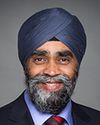In fact, as Minister Blair mentioned, the Canadian Armed Forces are used as a last resort. Since more extreme weather events and other emergencies have significantly increased the need, we need to make sure we have the proper capabilities built in at the municipal, provincial and federal levels.
What we want to do is make sure we have the right resources at the right places at the right time. The one you mentioned from Germany is something we are looking at actively. We are looking at other nations as well to see what's going to be suited to our country.
We're going to be going across the country to talk with the provinces and territories, especially at the local levels, with mayors. I was speaking with about five mayors just today and talking about what their needs are, to make sure we can respond to the uniqueness of each province and territory.





